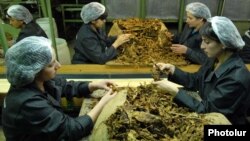Exports of Armenian cigarettes continued to grow rapidly last year thanks to a near-doubling of their deliveries to Iraq and Syria, their principal markets abroad, according to government statistics.
Data from the Armenian customs service revealed by Hetq.am shows a more than 71 percent surge in cigarette exports that totaled $116.6 million in 2014. They stood at just $16.3 million in 2011.
The Iraqi market generated over two-thirds of the Armenian tobacco industry’s total export revenue. This explains why Armenia’s trade with Iraq rose by almost 39 percent to $106 million in 2014.
The Armenian and Iraqi governments are eager to further expand bilateral trade, mainly carried out through Iran, with growing contacts between their senior officials as well as businesspeople from the two nations. In particular, they helped to launch in February a commercial flight service between Yerevan and Baghdad and Erbil, the capital of Iraqi Kurdistan where Armenia plans to open a consulate this year.
Iraq’s Transport Minister Baqir Jabr al-Zubeidi and a delegation of Iraqi businesspeople accompanying him arrived in Armenia on the inaugural Baghdad-Yerevan flight. Zubeidi called for closer Armenian-Iraqi commercial ties during talks with Armenian Economy Minister Karen Chshmaritian in Yerevan.
Another war-torn Arab state, Syria, became the second most important market for Armenian-made cigarettes in 2014. The Armenian customs service registered an almost six-fold increase in cigarette exports to Syria that were worth $18.2 million.
Virtually all of those cigarettes were manufactured by three tobacco firms that are part of the Grand Holding group founded by Hrant Vartanian, one of Armenia’s most famous businesspeople who died in April 2014.The conglomerate, which also comprises the country’s largest chocolate and confectionery manufacturer, is now owned and run by his two sons. Much of the tobacco used by it is grown in Armenia.
Grand Holding’s booming exports also helped to push up output in the broader Armenian tobacco industry. According to the National Statistical Service (NSS), it grew by more than half last year, accounting for 7.6 percent of the country’s overall industrial production.





